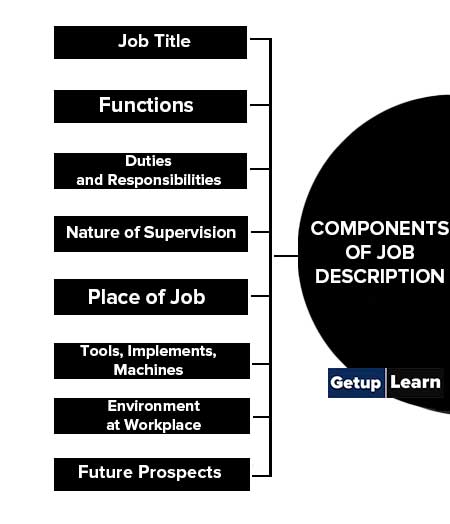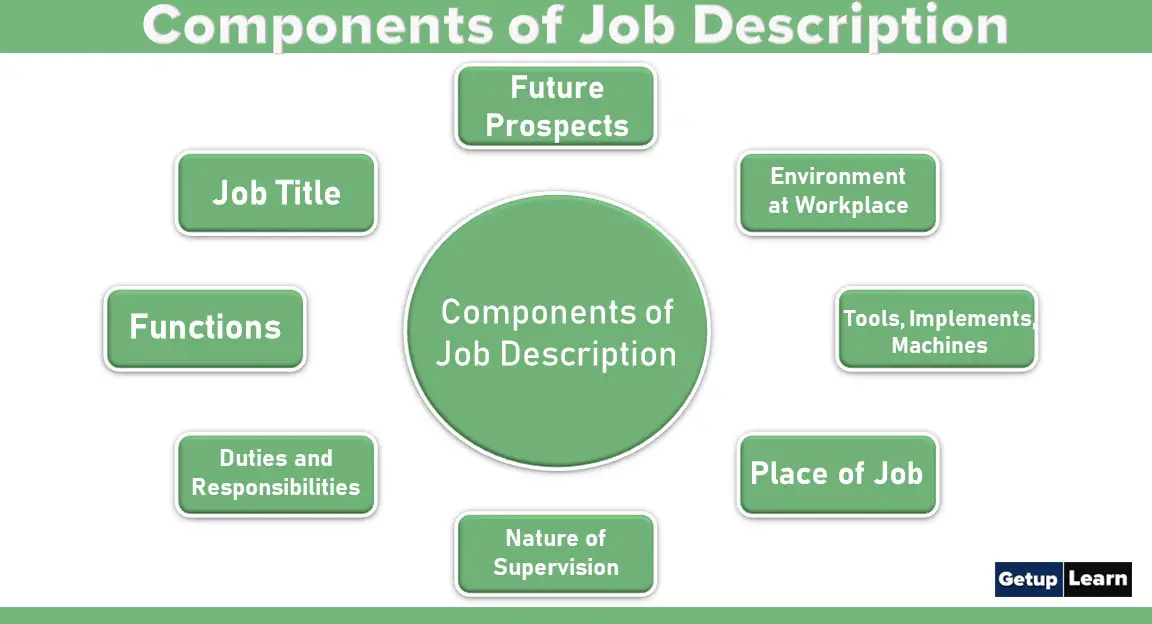Table of Contents
What is Job Description?
A job description is a written record of the duties, responsibilities, and requirements of a particular job. It is concerned with the job itself and not with the work. It is a statement describing the job in such terms as its title, location, duties, working conditions, and hazards. In other words, it tells us what is to be done and how it is to be done and why. It is a standard of function, in that it defines the appropriate and authorized contents of a job.

A job description is a list that a person might use for the general tasks, functions, and responsibilities of a position. It may often include to whom the position reports, specifications such as the qualifications or skills needed by the person in the job, or a salary range. Job descriptions are usually narrative, but some may instead comprise a simple list of competencies; for instance, strategic human resource planning methodologies may be used to develop a competency architecture for an organization, from which job descriptions are built as a shortlist of competencies.
A job description is usually developed by conducting a job analysis, which includes examining the tasks and sequences of tasks necessary to perform the job. The analysis considers the areas of knowledge and skills needed for the job. A job usually includes several roles.
According to Hall, The job description might be broadened to form a person specification or may be known as Terms Of Reference. The person/job specification can be presented as a stand-alone document though, in practice, it is usually included within the job description. A job description is often used in employment (a new position that needs to be filled).
A job description need not be limited to explaining the current situation, or work that is currently expected; it may also set out goals for what might be achieved in the future. A broad, general, and written statement of a specific job, based on the findings of a job analysis.
It generally includes duties, purpose, responsibilities, scope, and working conditions of a job along with the job’s title, and the name or designation of the person to whom the employee reports. Job description usually forms the basis of the job specification.
Components of Job Description
Following are the components of job description:
- Job Title
- Functions
- Duties and Responsibilities
- Nature of Supervision
- Place of Job
- Tools, Implements, Machines
- Environment at Workplace
- Future Prospects

Job Title
A suitable title for the job given that suggests the nature of the job, required skills, and other distinctive features of the job. For example account clerk, record keeper, lathe machine operator, computer programmer, system analyst, etc.
Functions
The functions of the jobs are clearly and precisely stated. For example, an account clerk’s functions include maintaining account books, ledgers, etc.
Duties and Responsibilities
The duties and responsibilities of the jobholder are classified into primary and secondary and the time taken for the performance of the job should be mentioned.
Nature of Supervision
The degree of supervision needed should be prescribed. Reporting authority should be mentioned. Certain jobs require close supervision while the jobs at higher levels require less supervision. Some managerial jobs require no supervision but others do require it. It should be clearly mentioned.
Place of Job
Place means the place where the job is to be performed by the jobholder i.e. the department, section, shop or office, etc.
Tools, Implements, Machines
The performance of certain jobs requires tools and implements, some require machines e.g. lathe machines, computers, etc. All these details are to be included in the job description. This will disclose the nature of the job and the complications involved in it which enable the planning training program.
Environment at Workplace
The environment at the workplace, the related hazards, and the possibility of accidents is to be mentioned so that it will help in evaluating the job.
Future Prospects
Anyone who is working on any job wants to be promoted after some period of time. It is, therefore, pertinent for the job analyst to mention the relationship, vertical and horizontal of the job. It will make the jobholder aware of his future growth by the way of promotion.
Advantages of Job Description
The job description not only reveals what, how, and why a job is to be done but also describes the job title, duties and responsibilities to be performed and authority assigned, and the distinct features of the job. It describes every aspect of the job.
A good job description possesses up-to-date information i.e. if amendments in duties and responsibilities are made then they should have been included, should indicate the job title, the extent of the job, limitations,s, and functions should be described in simple and understandable language, characteristics of the job, knowledge, and skills to perform the job should be included in the statement.
These are the advantages of job description:
- Job grading and classification.
- Transfers and promotions.
- Adjustments of grievances.
- Defining and outlining promotional steps.
- Establishing a common understanding of a job between employers and employees.
- Investigating accidents.
- Indicating faulty work procedures or duplication of papers.
- Maintaining, operating, and adjusting machinery.
- Time and motion studies.
- Defining the limits of authority.
- Indicating a case of personal merit.
- Facilitating job placement.
- Studies of health and fatigue.
- Scientific guidance.
- Determining jobs suitable for occupational therapy.
- Providing hiring specifications.
- Providing performance indicators.
What is the meaning of job description?
Job Description: It is a written record of the duties, responsibilities, and requirements of a particular job. It ‘is concerned with the job itself and not with the work’. It is a statement describing the job in such terms as its title, location, duties, and working condition hazards.
What are the components of job description?
Following are the components of job description:
1. Job Title
2. Functions
3. Duties and Responsibilities
4. Nature of Supervision
5. Place of Job
6. Tools, Implements, Machines
7. Environment at the Workplace
8. Future Prospects.

